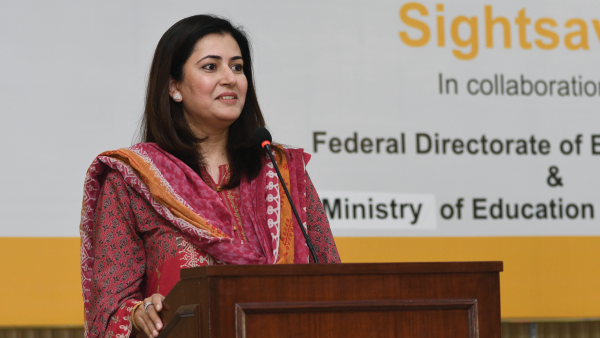A Unified View
Professor Paulo Eduardo Stanga on why optometrists and ophthalmologists need to work more closely together
Paulo E. Stanga, Consultant Ophthalmologist and Director of The Retina Clinic London, is a leading specialist in vitreoretinal surgery and disease, who has gained expertise in his long and illustrious career, with former roles at the Manchester Royal Eye Hospital, the Royal Liverpool University Hospital, Moorfields Eye Hospital, New York Hospital, and Cornell University Medical College.
An enthusiastic proponent of collaborative eye care, Stanga and his team have, for the past few years, been running very successful in-person seminars for optometrists at their London clinic. Here, he tells us how he is committed to educating optometrists about diagnostic/treatment options and clinical trials – and discusses the importance of strengthening the partnership between the professions.
Can you outline some of the education activities you have been providing for optometrists and why this is important?
With up to six seminars on different topics each year, we cover all aspects of retinal and vitreoretinal pathologies in the posterior pole, mid and far periphery with respect to diagnosis and management options. We are keen to improve referral patterns between optometrists and ophthalmologists. With outstanding advances, especially in recent years, in diagnostic imaging technologies and treatment options (such as gene therapy), optometrists need to be more aware than ever of what is available once the patient has been referred to the respective ophthalmologist.
At The Retina Clinic London, we’re fortunate to benefit from the most advanced diagnostic technologies under one roof; we have an on-site operating theater and access to all diagnostic methodologies – multiwavelength ultra-widefield imaging, navigated peripheral OCT, simultaneous ultra-widefield FFA/ICG with central and peripheral OCT, microperimetry, dark-adaptation, color anomaloscope, adaptive optics cellular imaging, electrophysiology, and more.
During the COVID-19 lockdowns, we ran our seminars as webinars, but as soon as the rules were relaxed we held the first face-to-face ophthalmology meeting in London!.
What are the key advantages of closer collaboration between ophthalmologists and optometrists?
Through better imaging and diagnostic capability in general, we can now diagnose a wider range of retinal and vitreoretinal pathologies in the specialist clinic setting. These pathologies may have gone unnoticed before. If and when the optometrist feels in doubt about the diagnosis of a retinal abnormality or illness, they should feel comfortable to refer the patient to a retinal consultant specialist for further diagnostics and care.
Moreover, there are now a broad range of clinical trials available to treat dry or wet age-related macular degeneration (AMD), diabetic macular retinopathy, retinitis pigmentosa, Stargardt’s Disease, and floaters, in particular. When optometrists are made aware of the existence of these trials, they can refer prospective patients to the ophthalmologist and establish if they are eligible for enrollment in such trials. This not only offers the patient the chance to undergo a full eye examination and receive treatments that may not be otherwise available, but it also helps to improve the development and approval of drugs.
Do you have any examples of how this collaboration has benefited patients?
In our practice, we run several clinical trials on-site at any given time. At the moment, we have trials for the treatment of naïve or already under treatment exudative AMD, geographic atrophy in dry AMD, diabetic maculopathy, and vitreous floaters and opacities. These clinical trials provide free-of-charge care to patients – plus, travel and accommodation expenses are covered with limits, depending on the trial. The patient feedback is fantastic!
We are also about to start trials on retinitis pigmentosa and Stargardt’s Disease and are very much looking forward to helping patients to improve their vision, given the debilitating nature of these two particular diseases. We are very proud and privileged to be involved in these trials as there is great potential to benefit patients who participate.
We also run a thriving Retina & Imaging Fellowship, which not only trains future generations of ophthalmologists, but also encourages and facilitates collaboration with optometrists.
How has the climate for optometry–ophthalmology collaboration changed over the course of your career?
The climate has certainly improved over the years. But from my point of view and throughout my career, optometrists and ophthalmologists have always had a close relationship. Early and adequately directed referrals to the specialist are crucial to bring about therapeutic success and improve the overall eye health of the entire population. What has certainly changed is that we have better diagnostic capabilities today, which allow the retinal specialist to address many more pathologies that before went unnoticed or there was simply no available treatment for them. It is today more important than ever for optometrists to work closely with the specialists to gain the best outcomes for their patients.
It is also essential for optometrists to know the specific centers that can take care of specific conditions, as this avoids unnecessary travel and visits for the patient, securing speedier access to treatment.
Equally, optometrists should know that new treatments may be available privately but not in the NHS; with the right knowledge, patients can be fully informed and not limited in choice. Optometrists should bear in mind that patients can access treatment through both the NHS and the private sector and that prompt access to diagnosis and treatment leads to better clinical outcomes.
Clearly, both professions are very important in the overall health care of the UK population. And it’s essential that both professions continue to work together closely. The way the two professions complement each other results in a unique setup that benefits patients.
How could closer partnership between the two professions be achieved?
By increasing the number of joint activities. We at The Retina Clinic London strongly believe in not only staying at the forefront of diagnostic and treatment modalities, but also – most importantly – focusing on improving our networking capacity and continuing to deliver on-site educational activities. We are very happy, as a private clinic, to provide such seminars and offer to the optometrist the opportunity to collect their required CME points through those educational activities. We also publish the results of our research in peer-reviewed scientific journals and make them known to the optometric community.
The New Optometrist Newsletter
Permission Statement
By opting-in, you agree to receive email communications from The New Optometrist. You will stay up-to-date with optometry content, news, events and sponsors information.
You can view our privacy policy here
Most Popular
Sign up to The New Optometrist Updates
Permission Statement
By opting-in, you agree to receive email communications from The New Optometrist. You will stay up-to-date with optometry content, news, events and sponsors information.
You can view our privacy policy here
Sign up to The New Optometrist Updates
Permission Statement
By opting-in, you agree to receive email communications from The New Optometrist. You will stay up-to-date with optometry content, news, events and sponsors information.
You can view our privacy policy here







